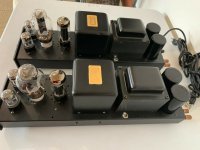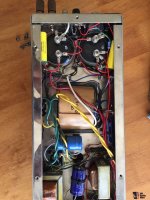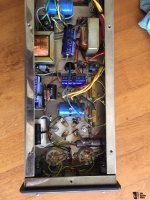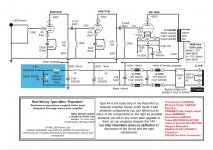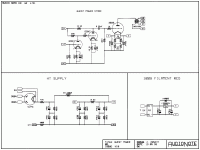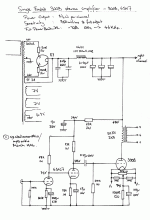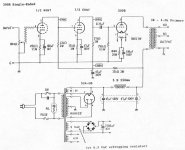So I had the opportunity to pick up some Cary 300b SE monoblock chassis for a decent price. The hope was to build a 300b as I have always wanted to build one.
I am in no way a seasoned amp builder. I know very little about how tube amplifiers work although I have spent some time reading the forums here to educate my self as much as possible. My work keeps me very busy so I can't really spend too much reading but I have rebuilt several amplifiers and a handful of tube amplifiers (ie Dynaco ST-70, Magnavox PP, and my current VTL ST-125MB). I am well aware of the extremely high voltages and the care that must be taken.
I was able to get my hands on the Cary CAD 300SE schematics using the 6SL7s. I was initially thinking of doing straight copy with sourced transformers. I have attached the schematic and some pics of what the amp should look like underneath. There are some minor differences as the pictures are of a newer model.
The issues I have come across is a lot of people are against using these tubes as the don't drive the 300b so well. Also people have stated issues with the size of the capacitors involved in the B+ rectification.
Can't say I know enough to really understand but the looking at the numbers it makes sense especially in regards to using the 6SL7.
At this point I have researched several other schematics and it can be rather overwhelming. I will attach some of the ones I was looking at in the next few posts.
I would appreciate any advice on the original Cary circuit and what people think about some of the other circuits. Thanks
I am in no way a seasoned amp builder. I know very little about how tube amplifiers work although I have spent some time reading the forums here to educate my self as much as possible. My work keeps me very busy so I can't really spend too much reading but I have rebuilt several amplifiers and a handful of tube amplifiers (ie Dynaco ST-70, Magnavox PP, and my current VTL ST-125MB). I am well aware of the extremely high voltages and the care that must be taken.
I was able to get my hands on the Cary CAD 300SE schematics using the 6SL7s. I was initially thinking of doing straight copy with sourced transformers. I have attached the schematic and some pics of what the amp should look like underneath. There are some minor differences as the pictures are of a newer model.
The issues I have come across is a lot of people are against using these tubes as the don't drive the 300b so well. Also people have stated issues with the size of the capacitors involved in the B+ rectification.
Can't say I know enough to really understand but the looking at the numbers it makes sense especially in regards to using the 6SL7.
At this point I have researched several other schematics and it can be rather overwhelming. I will attach some of the ones I was looking at in the next few posts.
I would appreciate any advice on the original Cary circuit and what people think about some of the other circuits. Thanks
Attachments
Here are a couple schematics I was also looking at based off the 6sn7. My impression was that the 6sn7 is a good tube to start off with and maybe tweaking the circuit over time.
Attachments
I've built and breadboarded a number of SE300B amps -- using input/driver tubes such as 6SN7, 6SJ7, 5842, and 6C6 -- and haven't really found any tubes that were "not good" for driving that tube. They're just different. Some may put out current or voltage that's too low to drive the 300B to full output, but that's not necessarily bad. Just depends on the design goal.
The first amp I built was the Tubelab SE, which used the 5842 to drive the 300B in a grid biased configuration. The 5842 can put out the maximum voltage and current (ca. 170V/8mA) for driving the 300B, and it was fine. But my favorites so far have been 6SJ7 and 6C6, which put out only about 2.5mA (in the WE91A, my favorite 300B circuit). They had audibly more "drive" and finesse, even with the 300B biased on the low side at between 50-60mA (most people seem to like it between 70-80mA). Maybe that was because there was more headroom in the combination.
At any rate, I'm not familiar with most of the schematics you posted, but any of them seem fine to me. The last one appears to be the Fi Primer 300B. That was the first 6SN7-300B circuit I built, and I would be happy to live with it. It's very dynamic and detailed, and also has enough gain that the input sensitivity is about 0.25mV -- meaning you can put a volume control on the input and run it straight from source; no preamp needed. It's also quite simple and would make a great starting point.
Joe Roberts' abridged WE91A from Sound Practices is definitely worth considering. That's my favorite 300B circuit so far. I'm currently working on my own WE91A, based on an original schematic using 6C6.
The first amp I built was the Tubelab SE, which used the 5842 to drive the 300B in a grid biased configuration. The 5842 can put out the maximum voltage and current (ca. 170V/8mA) for driving the 300B, and it was fine. But my favorites so far have been 6SJ7 and 6C6, which put out only about 2.5mA (in the WE91A, my favorite 300B circuit). They had audibly more "drive" and finesse, even with the 300B biased on the low side at between 50-60mA (most people seem to like it between 70-80mA). Maybe that was because there was more headroom in the combination.
At any rate, I'm not familiar with most of the schematics you posted, but any of them seem fine to me. The last one appears to be the Fi Primer 300B. That was the first 6SN7-300B circuit I built, and I would be happy to live with it. It's very dynamic and detailed, and also has enough gain that the input sensitivity is about 0.25mV -- meaning you can put a volume control on the input and run it straight from source; no preamp needed. It's also quite simple and would make a great starting point.
Joe Roberts' abridged WE91A from Sound Practices is definitely worth considering. That's my favorite 300B circuit so far. I'm currently working on my own WE91A, based on an original schematic using 6C6.
Have you heard the Cary's in their orginal form? Those were the amps that made me fall in love with 300B's and ProAc speakers. Don't knock the 6SL7. Gordon Rankin used it very succesfully, as did Cary.  That's an "SRPP" configuration. Low-impedance output and good voltage swing.
That's an "SRPP" configuration. Low-impedance output and good voltage swing.
Last edited:
Don't bother with the "Real McCoy." That fellow didn't know what he was doing. The other schematics are variations on the same theme. It's basically the first two stages of a Williamson design, the voltage amplifier and phase splitter, with a bypass cap on the second stage to turn into a driver stage. I've never found it to be the most robust-sounding front end for a 300B, and you sacrifice a lot of drive capability by direct-coupling the two stages. It was fine for driving a pentode but usually falls a bit short trying to swing enough volts to drive a 300B.
Last edited:
As Grover said. Have you heard them in your system? I know this is DIY and all...and it is a lot of fun to change an amp. But also frustrating if it doesn't live up to your high hopes. I personally also liked a we-91A variation instead using a SV83 as driver. I also liked my 300B with less voltage...just sounded less stressed.
That leads me to my next suggestion. Perhaps you should keep the circuit as is for now and try a choke input power supply. Sort of build a power supply for it a-la border patrol. Get rid of the lytic caps and go for some nice polypro or paper in oil.
That leads me to my next suggestion. Perhaps you should keep the circuit as is for now and try a choke input power supply. Sort of build a power supply for it a-la border patrol. Get rid of the lytic caps and go for some nice polypro or paper in oil.
Last edited:
There have been good suggestions already that are worth considering, but here's my experience. I had very good sounds from a 6K5GT (which is half of a 6SL7) driving the 300B, so I would not, out of hand, eliminate the 6SL7. Further, the most "transparent" and clear sound I got was by eliminating the coupling cap between the driver and the 300B: direct coupling.
Finally, I like the idea proposed above by Bas Horneman: build a high quality low impedance power supply to power both channels through umbilicals and do away with all the electrolytic caps. Build an outboard supply with enough voltage to allow you to direct couple the driver/300B with sufficient current for both channels. My own 300B choke input power supply can provide 550V @ 350mA with all MKP caps. I loose about 125V in the driver tube; see Electra-Print DRD amp.
Finally, I like the idea proposed above by Bas Horneman: build a high quality low impedance power supply to power both channels through umbilicals and do away with all the electrolytic caps. Build an outboard supply with enough voltage to allow you to direct couple the driver/300B with sufficient current for both channels. My own 300B choke input power supply can provide 550V @ 350mA with all MKP caps. I loose about 125V in the driver tube; see Electra-Print DRD amp.
Thanks a bunch for everyone's input. I think I should have been a little more clear in what I am starting with. I only have the bare chassis as pictured below. I would absolutely listen to the amps if they were complete. I actually talked to someone at Cary about getting new transformers. Price would set me back roughly $1200 for both power and output. Not terrible but I figured I would research a potentially better circuit before spending that much money. I think I could probably find equivalent transformers for less but I wasn't sure the exact specs for the output transformers. The power transformer I could probably figure out or at least makes slight adjustments to circuit to get a transformer to work.
Maybe someone at Cary would provide you with all the transformer specs. You might be able to get comparable off the shelf units for less money.
Last year I reverse-engineered several George Wright amps and preamps. I got specs and basic drawings from DMI, his power transformer winder for a time. They were not willing to reproduce an old design, even for a high price, so I ordered comparable Hammond units and they work very well. Having the info was also key to figuring out the operating points and other circuit parameters.
Last year I reverse-engineered several George Wright amps and preamps. I got specs and basic drawings from DMI, his power transformer winder for a time. They were not willing to reproduce an old design, even for a high price, so I ordered comparable Hammond units and they work very well. Having the info was also key to figuring out the operating points and other circuit parameters.
Thanks a bunch for everyone's input. I think I should have been a little more clear in what I am starting with. I only have the bare chassis as pictured below. I would absolutely listen to the amps if they were complete. I actually talked to someone at Cary about getting new transformers. Price would set me back roughly $1200 for both power and output. Not terrible but I figured I would research a potentially better circuit before spending that much money. I think I could probably find equivalent transformers for less but I wasn't sure the exact specs for the output transformers. The power transformer I could probably figure out or at least makes slight adjustments to circuit to get a transformer to work.
Sorry for the misunderstanding! Well, you've got lots of ideas to try. You could still try the Cary topology, just substitute an appropriate output transformer. 2.5-3K would probably be fine.
I would like to try the Cary topology but right now there are too many missing variables. I made a mistake in pricing and it would cost over 2K for both the output and power transformers. Not sure if there is a way to reverse the power transformer specs but I will look into it. There is also a second smaller transformer for the negative supply that I am unsure about.
You don't need to duplicate the transformers to try it. The CV378 rectifiers (GZ37) were cheap and plentiful when that amp came out. Now they're $100+ each. An 800VCT power transformer, a Gold Lion GZ34/5AR4 rectifier and a low-impedance choke (5H @ 150mA) will get you close enough for just about all those circuits. The bias tranny is a 6.3V filament tranny reversed, with the secondaries hooked up to the filament taps so you get 120VAC on the other end.
Get a nice 2.5K output transformer and build away. ;-)
Get a nice 2.5K output transformer and build away. ;-)
2K for output and power transformers is way too expensive.
A pair of Lundahl output transformers from kandkaudio (US importer) will set you back 300USD a pair. Around 200-300 for a pair of power transformers. Maybe another 100 for a pair of chokes.
Then there is Magnequest, O-Netics, Electraprint. And many many more.
A pair of Lundahl output transformers from kandkaudio (US importer) will set you back 300USD a pair. Around 200-300 for a pair of power transformers. Maybe another 100 for a pair of chokes.
Then there is Magnequest, O-Netics, Electraprint. And many many more.
hammond make a special 300B power transformer
you can make PSE https://www.hammfg.com/files/parts/pdf/300BX.pdf
and for output 125GSE its good or 1630SEA
i like also Toroidy in Polonia you can have two power and two 30/50Khz output for less of 500 euros
TTG-KT88SE - Tube output UL transformer [3kOhm] KT88 / 300B SE - Shop Toroidy.pl
TSTA 0250/002 - Mains transformer for tubes - Shop Toroidy.pl
for drive 300B i like 126B IT and 6C4C/6P45S-E
you can make PSE https://www.hammfg.com/files/parts/pdf/300BX.pdf
and for output 125GSE its good or 1630SEA
i like also Toroidy in Polonia you can have two power and two 30/50Khz output for less of 500 euros
TTG-KT88SE - Tube output UL transformer [3kOhm] KT88 / 300B SE - Shop Toroidy.pl
TSTA 0250/002 - Mains transformer for tubes - Shop Toroidy.pl
for drive 300B i like 126B IT and 6C4C/6P45S-E
Last edited:
Thanks for all the information. I was looking at the Hammond 300bx and 1630SEA combo or the Edcor CXSE25-3K and XPWR19
I was leaning towards the Edcor to get my feet wet and when the system is up and running decide on upgrading. Just need to spot check the dimensions to see how things line up with the chassis.
I was leaning towards the Edcor to get my feet wet and when the system is up and running decide on upgrading. Just need to spot check the dimensions to see how things line up with the chassis.
Last edited:
What I notice about the Cary 300B amp schematic:
With 450V across the 300B, I bet it is not a 2.5k or a 3k primary. Use 450V, and a 2.5k or 3k primary only if the 300B is run very hot (88.9mA current x 450V = 40 Watts).
450V would require less current unless you want to cook the tube. And it should be noted that Western Electric revised the 300B spec to 36 Watts max, not the old 40W max. spec.
450V and less current would sound better with a 3.5k to 5k primary. And you would not cook the 300B. 3.5k more power, 5k more damping. The problem with using 450V and less than 88.9mA current, is that the grid negative fixed bias will be larger, and so any driver tube has to swing more voltage (and do so linearly).
The schematic does not show whether it is AC or DC for the 5V filament.
How sensitive are your speakers? dB/meter at 2.83V? What is your nominal speaker impedance? What minimum damping factor do they need?
AC versus DC filament decision is important. The schematic does not show a hum buck adjustment, so it is probably 5VDC And as discussed in several forum threads, DHT and AC filaments = Intermodulation at 2X 50 Hz or 60 Hz line frequency (100 Hz or 120 Hz).
There is no negative feedback shown. Good, this is a DHT amp. And, that means there are no stability problems to fight, even if you use a much different output transformer.
But as you can see we are taking the Cary 300B amp and reverse engineering, re-engineering, or both.
I like your idea of using the Hammond or Edcor transformers, but could not find the Edcor XPWR 19 that you speced.
Depending on your speakers, room, and music tastes, I would expect you to be pleased with the sound.
With 450V across the 300B, I bet it is not a 2.5k or a 3k primary. Use 450V, and a 2.5k or 3k primary only if the 300B is run very hot (88.9mA current x 450V = 40 Watts).
450V would require less current unless you want to cook the tube. And it should be noted that Western Electric revised the 300B spec to 36 Watts max, not the old 40W max. spec.
450V and less current would sound better with a 3.5k to 5k primary. And you would not cook the 300B. 3.5k more power, 5k more damping. The problem with using 450V and less than 88.9mA current, is that the grid negative fixed bias will be larger, and so any driver tube has to swing more voltage (and do so linearly).
The schematic does not show whether it is AC or DC for the 5V filament.
How sensitive are your speakers? dB/meter at 2.83V? What is your nominal speaker impedance? What minimum damping factor do they need?
AC versus DC filament decision is important. The schematic does not show a hum buck adjustment, so it is probably 5VDC And as discussed in several forum threads, DHT and AC filaments = Intermodulation at 2X 50 Hz or 60 Hz line frequency (100 Hz or 120 Hz).
There is no negative feedback shown. Good, this is a DHT amp. And, that means there are no stability problems to fight, even if you use a much different output transformer.
But as you can see we are taking the Cary 300B amp and reverse engineering, re-engineering, or both.
I like your idea of using the Hammond or Edcor transformers, but could not find the Edcor XPWR 19 that you speced.
Depending on your speakers, room, and music tastes, I would expect you to be pleased with the sound.
Last edited:
Cary 300B, continued . . .
Oh, I forgot, the 6SL7 filaments need to be elevated (it is an SRPP with one cathode elevated). A two resistor voltage divider off the B+, and one bypass cap will do it.
Either a center tapped 6.3V winding, or 2 more resistors to create a pseudo center tap to connect the elevating voltage to.
Oh, I forgot, the 6SL7 filaments need to be elevated (it is an SRPP with one cathode elevated). A two resistor voltage divider off the B+, and one bypass cap will do it.
Either a center tapped 6.3V winding, or 2 more resistors to create a pseudo center tap to connect the elevating voltage to.
I tried to get Cary to tell me the primary resistance of the output transformer but haven't had any luck. The Hammond I ordered was 3.5K. Based on the schematic the current is biased at 83mA. I will have to read a little more to better understand what is going on. I know I have read a few threads stating the current schematic and 6SL7 has a tough time driving the 300b because of the voltage swing. Thanks for the information.What I notice about the Cary 300B amp schematic:
With 450V across the 300B, I bet it is not a 2.5k or a 3k primary. Use 450V, and a 2.5k or 3k primary only if the 300B is run very hot (88.9mA current x 450V = 40 Watts).
450V would require less current unless you want to cook the tube. And it should be noted that Western Electric revised the 300B spec to 36 Watts max, not the old 40W max. spec.
450V and less current would sound better with a 3.5k to 5k primary. And you would not cook the 300B. 3.5k more power, 5k more damping. The problem with using 450V and less than 88.9mA current, is that the grid negative fixed bias will be larger, and so any driver tube has to swing more voltage (and do so linearly).
I suspected it was DC as it comes off the bridge rectifier (there should be a second page with schematic showing power supply... I'll double check first post).The schematic does not show whether it is AC or DC for the 5V filament.
The 300bx I am picking up has 6.3V CT 6A so I am hoping to be able to provide enough current for both 6SL7s and the 300b. In the future I'll probably separate these out and make separate regulated voltages.
Speakers are old school Klipsch Cornwalls so pretty sensitive at around 98.5How sensitive are your speakers? dB/meter at 2.83V? What is your nominal speaker impedance? What minimum damping factor do they need?
Ya the Edcor part number was a typo but using the Hammond anywaysAC versus DC filament decision is important. The schematic does not show a hum buck adjustment, so it is probably 5VDC And as discussed in several forum threads, DHT and AC filaments = Intermodulation at 2X 50 Hz or 60 Hz line frequency (100 Hz or 120 Hz).
There is no negative feedback shown. Good, this is a DHT amp. And, that means there are no stability problems to fight, even if you use a much different output transformer.
But as you can see we are taking the Cary 300B amp and reverse engineering, re-engineering, or both.
I like your idea of using the Hammond or Edcor transformers, but could not find the Edcor XPWR 19 that you speced.
Depending on your speakers, room, and music tastes, I would expect you to be pleased with the sound.
- Status
- This old topic is closed. If you want to reopen this topic, contact a moderator using the "Report Post" button.
- Home
- Amplifiers
- Tubes / Valves
- 300b SE Build
